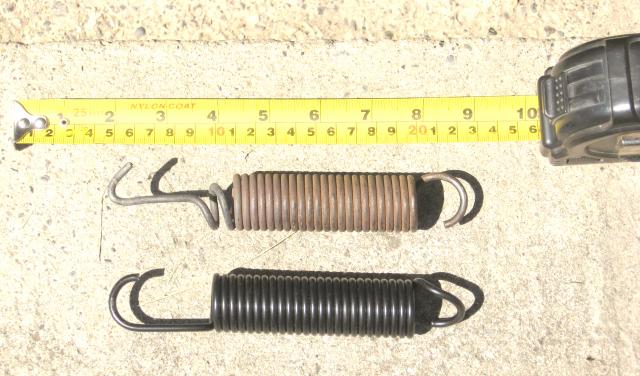Joel_BC
Super Self-Sufficient
I needed to do a "make-do" machine part repair for our lawn tractor. The repair involved a coil spring (part of the mower deck-assembly lifting mechanism). The spring had snapped at one end, where spring's end had a hook formed in it: a C-shaped loop.
To give a sense of what the spring is, its is made from 2.5mm (1/10 inch) spring-steel wire, the coil being about 3/4-inch outside diameter, and the coiled portion is a bit over 3.5-inch long. Not "a really big spring" but not a tiny one either. To show what the item looks like, here's a picture of the old one (which I repaired) and the replacement, which I finally was able to obtain by mail order.

The snapped-off end had been on the left.
Using an oxy-acetylene flame (I used a small brazing tip), I extended a bit of wire out from the coil and then re-hooked the end. I didn't know enough about spring steel to know whether I should quench the hot end, in water or oil, in order to restore enough temper that the hook end would hold some shape. I was surprised that the wire, which I didn't quench, regained its "springiness" and worked well. Also, importantly, it did not get too brittle.
The pic shows the original spring that I did the wire-bending repair on, and the replacement that eventually reached me, shipped from a distant John Deere dealership. You can see the spring's wire is fairly heavy. Also, while I did not get the end shape quite the same as the original had, I was able to mount it in its normal situation, and it did stay in place.
I was able to rely on the repaired spring for over a week until a new one, ordered from the John Deere retailer, arrived. Who knows how long (or short) a time my "repaired" spring would have done the job before it snapped at the end I'd worked on? But I was able to get by with it. For all I know it might have lasted indefinitely.
To give a sense of what the spring is, its is made from 2.5mm (1/10 inch) spring-steel wire, the coil being about 3/4-inch outside diameter, and the coiled portion is a bit over 3.5-inch long. Not "a really big spring" but not a tiny one either. To show what the item looks like, here's a picture of the old one (which I repaired) and the replacement, which I finally was able to obtain by mail order.

The snapped-off end had been on the left.
Using an oxy-acetylene flame (I used a small brazing tip), I extended a bit of wire out from the coil and then re-hooked the end. I didn't know enough about spring steel to know whether I should quench the hot end, in water or oil, in order to restore enough temper that the hook end would hold some shape. I was surprised that the wire, which I didn't quench, regained its "springiness" and worked well. Also, importantly, it did not get too brittle.
The pic shows the original spring that I did the wire-bending repair on, and the replacement that eventually reached me, shipped from a distant John Deere dealership. You can see the spring's wire is fairly heavy. Also, while I did not get the end shape quite the same as the original had, I was able to mount it in its normal situation, and it did stay in place.
I was able to rely on the repaired spring for over a week until a new one, ordered from the John Deere retailer, arrived. Who knows how long (or short) a time my "repaired" spring would have done the job before it snapped at the end I'd worked on? But I was able to get by with it. For all I know it might have lasted indefinitely.
